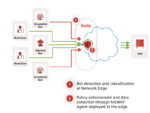
Way back in 1962, Marshall McLuhan, a leading communication theorist, said that the new electronic independence that was being experienced by millions of people across the globe would lead to what he called the creation of a global village. Fast forward 60 years and there is no argument that McLuhan was ahead of his time.
We now live in a connected society, where seamless digital experiences are not only expected but also considered to be the minimum requirement for successful customer engagement and brand interaction. And while multiple touchpoints are the norm in the 21st century, the integration of data-based solutions that can deliver what a person wants when they want is both a competitive advantage and a platform for innovation.
In recent years, cloud has become ubiquitous across many business verticals. Cloud computing – the on-demand delivery of compute power, database storage, applications and other IT resources through a cloud services platform via the internet – has seen increased adoption, but there is already a shift to a more efficient way of distributing and analyzing data.
Welcome to the Edge
For companies that work on the real-time interpretation of data and actionable insights, the need to incorporate what is known as edge computing has become paramount. If you think about how connected the world actually is, then the closer to a data storage location you are, the quicker you can utilize the data that you need.
As its name would imply, edge computing works at the edge of a network as opposed to being fully reliant on cloud and its physically distributed data centers. This allows a company to analyze, process and transfer data over a short distance, with an overarching aim of being close to the point where the data is created or collected.
This becomes increasingly important when you factor in the sort of connected devices that benefit from real-time data processing. Autonomous vehicles and drones, health monitoring devices, smart home equipment, traffic management devices, remote monitoring and (ironically) cloud gaming … all of these sectors rely on instantaneous interpretation of data and actionable insights.
It should be noted, however, that edge is not a standalone solution, rather it is what MIT Horizon refers to as “a supplemental field – its techniques and applications only exist in relation to other technologies.”
In fact, it is important to understand that while edge is an incredible advancement, the process does not eliminate the need for cloud solutions. It is no secret that the cloud has completely changed the world of technology by allowing people across the globe to store their data easily and safely.
As we enter an era of hypergrowth for IoT and IIoT, multiple devices will need to be added to the connected ecosystem, and the consolidation of the data produced by these devices will still need to be done in the cloud. For that reason, having edge computation as a mediator between IoT devices and the Cloud won’t pose any threats to cloud providers. Both of the services together will be able to provide better storage and a complete computation strategy to enterprises.
Data Processing gets Edgy
The question that we need to ask is, how will edge computing impact the way that we process data now?
There is little doubt that edge offers significant advantages in terms of workload and streamlining business intelligence. A recent report by IDC said that the rapid deployment of edge is “significantly shaping workload evolution,” with the analyst noting that investment was likely to become more of priority as companies look to augment physical spaces with digital tools. For that reason alone, successful integration of edge would require a symbiotic relationship to form within the enterprise workload itself.
In addition, we can see that edge offers endless resources for storage and computation, with users given the ability to scale reliably and comprehensively. We all know that maintaining cybersecurity and ensuring the physical security of data centers is always a challenge, but edge computing centers will also require stakeholders to ensure that the data is secure at all times.
We should also be careful that edge and cloud computing are not treated differently.
Both follow similar principles, but edge brings the data closer to its source destination. Cloud relies on massed banks of servers, while the physical proximity of edge processors to the end user means that the data is more localized and, importantly, not located in another part of the country (or even a different continent). This allows companies to transfer or process data quicker at a fraction of the cost – data transfers aren’t free and cloud providers are more than happy to charge for each megabyte that travels through a network.
Edge Computing, Taking Data to a New Level
According to a recent report from Gartner, edge computing will impact two core areas.
First, it will prioritize a distributed cloud solution over a centralized, or monolithic, cloud architecture, expanding the storage and computation in a way that hasn’t been done before. Second, cloud providers will have no choice but to identify cloud computing as a default ecosystem.
By 2023, it is estimated that only 20% of installed edge computing platforms will be delivered and managed by hyperscale cloud providers who currently own massive data centers across the globe. This shows the level of growth opportunity there truly is for cloud/edge computing as partnerships will have no choice but to emerge in providing the best experience for all users.
And while taking data processing to the edge may seem to be the logical path to follow, the key point to remember is that this will not negate the need for cloud. Companies will still need to run workloads in the global village, but how they decide to do that will come down to how local they need to be.








